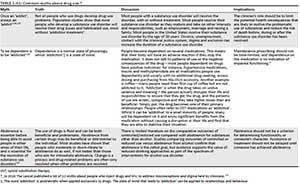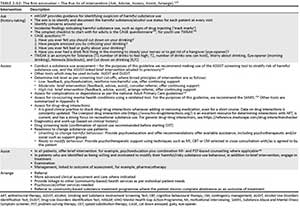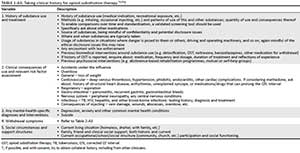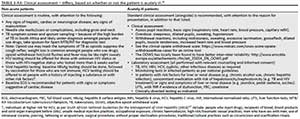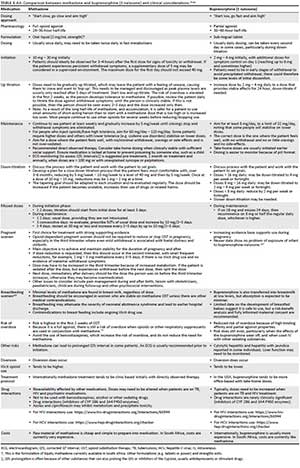Services on Demand
Article
Indicators
Related links
-
 Cited by Google
Cited by Google -
 Similars in Google
Similars in Google
Share
Southern African Journal of HIV Medicine
On-line version ISSN 2078-6751
Print version ISSN 1608-9693
South. Afr. j. HIV med. (Online) vol.21 n.1 Johannesburg 2020
http://dx.doi.org/10.4102/sajhivmed.v21i1.1161
GUIDELINE
Southern African HIV Clinicians Society guidelines for harm reduction
Andrew ScheibeI, II; Goodman SibekoIII; Shaun ShellyI, II; Theresa RossouwIV; Vincent ZishiriV; Willem D.F. VenterV
ITB HIV Care, Cape Town, South Africa
IIDepartment of Family Medicine, University of Pretoria, Pretoria, South Africa
IIIDepartment of Psychiatry and Mental Health, University of Cape Town, Cape Town, South Africa
IVDepartment of Immunology, University of Pretoria, Pretoria, South Africa
VEzintsha, Faculty of Health Sciences, University of the Witwatersrand, Johannesburg, South Africa
Table of contents
Executive summary
1.Introduction
1.1 Harm reduction
1.2 Drugs and drug use
1.2.1 Patterns of use
1.2.2 Methods of drug use
1.2.3 Drug classifications and common drugs
1.2.4 Epidemiology of drug use in southern Africa
1.2.5 Drug-related harms
1.2.6 Reasons for drug use
1.2.7 The relevance of harm reduction
1.3 Stigma, discrimination and human rights
2.Evidence-based interventions
2.1 A guiding framework
2.2 Assessing a person's needs
2.2.1 Screening and brief intervention for common mental disorders and harmful substance use
2.2.1.1 Screening
2.2.1.2 Brief interventions
2.2.1.3 Referral for treatment
2.3 HIV prevention
2.3.1 Condoms and lubricant
2.3.2 Pre- and post-exposure prophylaxis
2.3.3 Voluntary medical male circumcision
2.4 Harm reduction interventions
2.4.1 Needle-and-syringe services
2.4.2 Opioid substitution therapy
2.4.3 Overdose services
2.4.4 Emerging and ancillary interventions
2.4.4.1 Harm reduction for people who use stimulants
2.4.4.2 Drug consumption rooms
2.4.4.3 Drug-checking services
2.5 HIV testing, treatment and care
2.5.1 HIV testing and counselling
2.5.2 Antiretroviral therapy
2.5.3 Prevention of mother-to-child transmission of HIV
2.6 Prevention and management of coinfections and comorbidities
2.6.1 Tuberculosis services
2.6.2 Viral hepatitis services
2.6.3 Mental health services
2.6.4 Sexual and reproductive health services
2.7 Critical enablers
2.7.1 Supportive law and policy
2.7.2 Countering stigma and discrimination
2.7.3 Enabling community empowerment
2.7.4 Acting against violence
3.Special considerations
3.1 Young people who use drugs
3.2 Women who use drugs
3.3 Substance use in the context of sexual encounters
3.4 Prison settings
4.Recommendations
5.Acknowledgements
Glossary
References
1.Appendix 1: Common myths about drugs use
2.Appendix 2: Assessing patients during first and subsequent encounters
3.Appendix 3: Guidelines for opioid substitution therapy
4.Appendix 4: Psychosocial and mental health interventions
Executive summary
We support public-health-focused interventions, as opposed to recovery-focused interventions. We support the decriminalisation of drug use as much as we oppose the criminalisation of sex work, mandatory HIV disclosure and policing of sexual preferences.
In South Africa, despite existing policy that embraces drug harm reduction, population- and individual-level interventions have focused largely on the singular goal of abstinence. This greatly impacts the human rights of people who use drugs and their communities. The failure of countries to implement comprehensive harm reduction measures violates their obligations in international human rights law and public health.
These guidelines were developed to provide information for healthcare workers working in the field of HIV and related conditions to address gaps in knowledge around drug use and build capacity around harm reduction and delivery of relevant evidence-based clinical interventions. The guidelines include an emphasis on people who use drugs who are at risk of experiencing harms relative to HIV, viral hepatitis and other related conditions.
As with critical areas within HIV, the social context, including social support, stigma and structural drivers such as employment, is important for health workers to understand. Harm reduction requires clinicians to understand the broader context in which drugs are used by their patients. The traditional 'just say no' approaches to drug use are as ineffective for drug use as they are for sex. Clinicians have an ethical obligation to their patients that extends to being advocates for evidence-based harm reduction.
Drug 'harm reduction' takes a pragmatic view that is humane, effective, holistic and fundamentally concerned with the rights of people who use drugs, their socio-economic context and the provision of services that are responsive, preventive and supportive. This approach also enhances the well-being of partners, family members and society at large.
Harm reduction approaches and related interventions are supported by a large body of evidence. Explicit support for needle-and-syringe services is included in the South African National Strategic Plan for HIV, TB and STIs (2017-2022), the National Drug Master Plan (2019-2024) and the National Hepatitis Action Plan. A National Department of Health policy around opioid substitution therapy and related clinical guideline is under development.
By integrating the guidelines in clinical practice, the quality of care provided by clinicians to people who use drugs will be enhanced - benefitting individuals and communities of people who use drugs and broader society.
Scope and purpose of the guidelines
•Review evidence of the harm reduction approach
•Briefly review the epidemiology of drug use and its consequences
•Present clinical guidance for harm reduction interventions aligned with the framework developed by the World Health Organization
•Provide guidance around brief screening and interventions related to drug use
•For each harm reduction intervention, provide: a summary of evidence, main principles and links to related guidelines
•Highlight special considerations for young people who use drugs, women who use drugs, substance use and sexual encounters and drug use within prison settings
•Provide selected recommendations for stakeholders engaged in the delivery of harm reduction services in HIV, TB, viral hepatitis and related services.
Audience
These guidelines are aimed primarily at clinicians (doctors, nurses and clinical associates). Other stakeholders who will benefit from this guideline include pharmacists, HIV and health programme officers and policymakers.
Methods
A core writing team developed these guidelines. The process was informed by a review of evidence and guidance from the World Health Organization. A stakeholder consultation was held in August 2019, followed by international peer review. Inputs and recommendations were included.
1. Introduction
1.1 Harm reduction
People have always used drugs to alter health, perceptions, relationships and state of mind1 and this is not likely to change. Globally, in 2017, more than 271 million people had used unregulated drugs in the preceding year.2
The criminalisation of people who use certain drugs increases levels of stigma, encourages misinformation and contributes to harms, including high rates of preventable deaths.3 A purely biomedical approach - that presumes that all people who use drugs require treatment, and all drug use and dependence represents a disease requiring specialist medical intervention - carries the risk of stigma and often fails to pay due attention to the social and economic context in which dependent drug use occurs.3 Criminalisation and the pathologisation of drug use may intensify social disruption and hinder the provision of effective responses.4
Countries that have implemented comprehensive harm reduction programmes have managed to turn around epidemics of HIV and hepatitis C virus (HCV) infection. Overdose deaths are lower in contexts where harm reduction services are in place, compared with places where they are not. Harm reduction reduces the adverse health, social and economic consequences of drug use without necessarily reducing drug consumption.5 In 2018, 86 countries (11 in Africa) had at least one needle-and-syringe service and 86 (nine in Africa) had at least one opioid substitution therapy (OST) programme.
Harm reduction refers to policies, programmes and practices that aim to minimise negative health, social and legal impacts associated with drug use, drug policies and drug laws. Harm reduction is grounded in justice and human rights - it focuses on positive change and on working with people without judgement, coercion, discrimination, or requiring that they stop using drugs as a precondition of support. Harm reduction encompasses a range of health and social services and practices that apply to illicit and licit drugs. These include, but are not limited to, drug consumption rooms, needle and syringe programmes, non-abstinence-based housing and employment initiatives, drug checking, overdose prevention and reversal, psychosocial support and the provision of information on safer drug use. Approaches such as these are cost-effective, evidence-based and have a positive impact on individual and community health. (Harm Reduction International).6
Key points
•Harm reduction is an evidence, rights and public-health-based approach that reduces risks and improves the health and well-being of people who use drugs and the broader community.
•Long-term policies and interventions are needed to address structural factors that contribute to harms related to drug use.
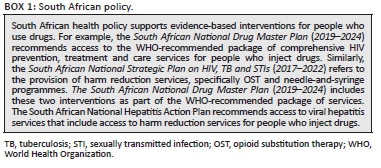
Harm reduction principles for healthcare settings are listed.7
•Humanism: Care is given without moral judgement and with an understanding that choices are contextual.
•Pragmatism: The priority is the here and now, and the mitigation of immediate risk is what matters most.
•Individualism: People are different and have their own needs and strengths.
•Autonomy: People have a right to make informed choices, even against expert advice.
•Incrementalism: Any positive change is viewed as an improvement on current circumstances.
•Accountability without termination: People have the right to make choices, without their access to services being denied in relation to their decisions.
The application of these principles can improve patient-clinician relationships. The impact of harm reduction is increased through community engagement and peer-led services as well as removing barriers and increasing support.
Key points
•Harm reduction is an evidence, rights and public-health-based approach that reduces risks and improves the health and well-being of people who use drugs and the broader community.
1.2 Drugs and drug use
1.2.1 Patterns of use
Depending on the drug, 8% - 15% of people who use drugs develop a problem with their use. Drug use occurs along a continuum and can shift according to various factors (see Table 1).
1.2.2 Methods of drug use
Drugs can be taken by different administration modes, which can lead to different effects and varying degrees of harm. For instance, intravenous (IV) administration is associated with rapid onset and peak of action, with elevated risks: for opioids, this includes overdose and for stimulants, such as cocaine, this includes arrhythmia. Common methods of drug use are summarised here.
•Smoking is the most common form of use for cannabis, methaqualone (mandrax), heroin (whoonga, nyaope, sugars) and methamphetamine (tik, crystal meth) in southern Africa. Onset of action is faster than other forms of use. Risks are related to airways and pulmonary disease.
•Nasal inhalation (snort, schnarf, toot, sniff) is often used for cocaine, but also heroin. Onset of action is quick and is associated with risk of damage to the nasal mucosa.
•Injecting (slam, spike, smoke) can be done through several routes, most commonly IV. Heroin is the most injected drug, followed by methamphetamine and cocaine. Onset of action is very rapid. Risks are largely related to the use of contaminated injecting equipment and poor hygiene practices, including local and blood-borne infections (notably HIV, hepatitis B virus [HBV] and HCV). The risk of overdose is higher if drugs are injected. A proportion of people who use opioids and/or stimulants for a long period of time will transition to injecting.
•Oral ingesting (pop) is the most common route for gamma-hydroxybutyric acid (GHB), alcohol, methadone and ecstasy, amongst others. Onset is slower and risks may vary depending on the food or liquids consumed.
•Rectal suppository or vaginal (booty bumping) administration are less frequent methods of substance intake.
1.2.3 Drug classifications and common drugs
Drugs can be categorised into five broad classes according to their primary effects: stimulants, depressants, hallucinogens, cannabinoids and antipsychotics. An overview of common drugs is given in Table 2.
1.2.4 Epidemiology of drug use in southern Africa
As a result of the illegal nature of drug use and associated stigma, obtaining robust data on drug use is difficult and data are limited (see Table 3). It is therefore likely that estimates of reported use and risks are under-reported. Research reflects increased trafficking of heroin in the region and a review of substance use treatment data in South Africa points to a six-fold increase in heroin-related admissions over the last decade, with marked increases seen in methamphetamines and other stimulant-related admissions during the same period.13
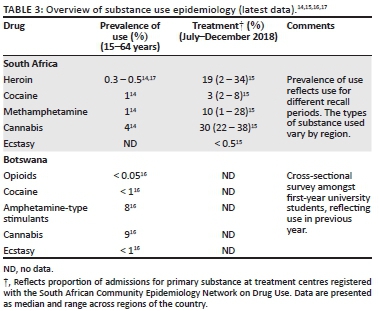




1.2.5 Drug-related harms
The harms related to drugs are embedded in social and structural circumstances, including stigma, which is often driven by the illicit nature of drug use. For a variety of reasons, the production, sale and use of certain drugs are restricted or highly regulated through international agreements.18 People who use drugs, especially those who inject drugs, are vulnerable to several health issues including HIV, viral hepatitis, cellulitis and infective endocarditis.19 People who use drugs are also at increased risk of developing tuberculosis (TB).20 Long-term smoking of drugs (including cannabis, methaqualone or heroin), particularly amongst people who also smoke tobacco products, can increase risks for the development of chronic obstructive airways disease and emphysema.21,22 Globally, the incidence of HIV infection has declined, yet infections amongst people who use drugs continue to increase.23
The quantification of drug-related harms in South Africa, including HIV and viral hepatitis infections and overdose, is inadequate. Table 4 provides a snapshot of available data.
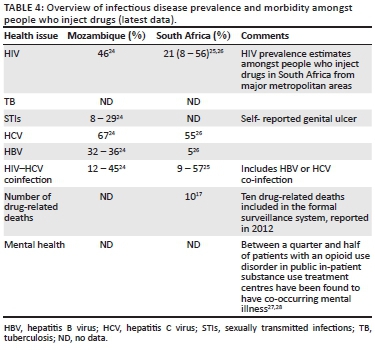
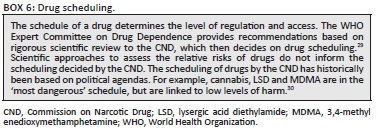

1.2.6 Reasons for drug use
The reasons why people are using drugs outside of supervised medical care are poorly understood. The dominant discourses to explain this phenomenon are often based on moral or political foundations rather than science. It is beyond the scope of these guidelines to provide a comprehensive analysis of the use of drugs. People use drugs for a range of reasons (Table 5),31 and many myths exist in the context of clinical care around people who use drugs (see Appendix 1).32
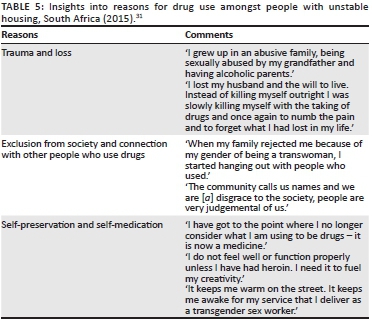
Chronic problematic drug use is largely caused by personal, social, cultural and political pain and suffering (and at times may also include psychological, physiological and legal issues).33

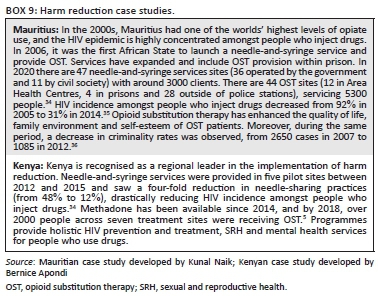
1.2.7 The relevance of harm reduction
It will take a long time to affect a significant reduction in the number of drugs used, and the harms caused because this requires structural reform, which is explored later. The historical focus on abstinence and law enforcement has been ineffective and resulted in significant harm. Harm reduction is an effective public health intervention. It keeps people alive and reduces drug-related morbidity. For individuals, harm reduction aligns with the tenets of medical ethics in that it is beneficent and patient centred. It takes a longer-term view and helps people meet their goals in a stepwise manner. Specific harm reduction interventions relevant to people who use drugs are covered in the section 'Evidence-based interventions'.
Key points
•People use drugs for many reasons, in an array of circumstances and contexts and this cannot be modified rapidly.
•Not all drug use is harmful.
•Addressing drug use in isolation will seldom result in a sustained resolution, unless the underlying motivators are addressed.
•People use drugs in different ways; drugs are mostly smoked in South Africa, but injecting is becoming more prevalent.
•Drug-related risks and effects depend on the drug, (mind-)set and setting.
•The use of opioids and amphetamine-type stimulants in the region is increasing.
•In the context of criminalisation, many people who use drugs enter and exit the criminal justice system, placing them at risk for HIV and other infectious diseases.
•The burden of HIV, viral hepatitis and TB amongst people who use drugs in the region is high.
1.3 Stigma, discrimination and human rights
Stigma is a process of exclusion; it occurs when a person - or group of people - are tainted or disgraced. When people perceive themselves as being stigmatized, they may also come to hold the same negative perceptions about themselves, leading to an internalization of stigma and acceptance of a 'spoiled identity'.37
Stigma, misinformation and the lack of evidence-based harm reduction approaches are major contributing factors to the vulnerabilities people who use drugs face. Stigma is often not prioritised by healthcare professionals, yet has a profound effect on the relationships between clinicians and their patients.38
The use of non-stigmatising language can enhance relationships with patients and clinical outcomes. Table 6 outlines alternative supportive language to use.
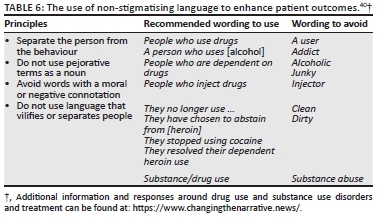
'Stigma in health facilities undermines diagnosis, treatment, and successful health outcomes. Addressing stigma is fundamental to delivering quality healthcare and achieving optimal health.'39
The International Network of People Who Use Drugs (INPUD) recognises that language cannot be regulated, and that context can transform a term that is used to oppress into one through which emancipation is pursued … Ordinarily, however, language that may denigrate, is best avoided.40
Discrimination, which is the enactment of stigma, also needs to be addressed and the rights of all people secured. Many governments in the region have signed the International Covenant on Economic, Social and Cultural Rights,40 which outlines the range of rights that are relevant to people who use drugs in health settings. Some of the relevant rights are: the right to self-determination (Article 1); the right to non-discrimination based on race, colour, sex, language, religion, political or other opinion, national or social origin, property, birth or other status (Article 2); and the right to enjoy the highest attainable standard of physical and mental health (Article 12). People who use drugs experience frequent violation of these rights, which increases the harms of drug use - including confiscation of sterile injecting equipment and medication that forms part of substance use disorder treatment or other health conditions.41
Key points
•People who use drugs frequently experience stigma, discrimination and human rights violations, which negatively affect their health and well-being.
•The use of appropriate language is an important component of providing support services.
2. Evidence-based interventions
2.1 A guiding framework
These guidelines are built upon the framework set out in the WHO Consolidated Guidelines on HIV Prevention, Diagnosis, Treatment and Care for Key Populations,19 including health sector interventions (Table 7) and critical enablers (Table 8).
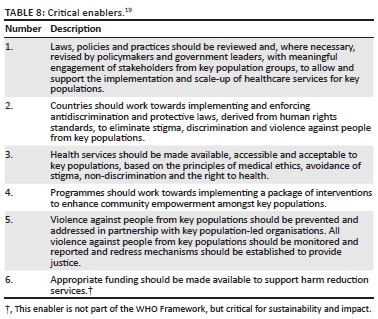
2.2 Assessing a person's needs
The screening for substance use and offer of assistance for potentially harmful substance use can take place in a range of clinical scenarios (see Appendix 2). The integration of screening for substance use and mental health conditions, linked to brief interventions and referral for further treatment, is often the first step in supporting people within a harm reduction approach and is outlined here.
2.2.1 Screening and brief intervention for common mental disorders and harmful substance use
Substance use disorders fall into the category of common mental disorders. Harmful alcohol and other drug use and other mental health disturbance may result in an increased risk of contracting HIV and in substantial health problems amongst people living with HIV. However, it is important to note that most people who use drugs do so on an occasional basis and will not develop a substance use disorder (dependence). For this group, there may be little need for high-intensity interventions. Screening for other common mental disorders including depressive disorders and anxiety disorders should also be performed. These may arise because of psychosocial distress that may be related to the HIV diagnosis or as a consequence of infective processes, which may be primary or secondary in a patient living with HIV. Identification of these is essential as they may impact on clinical outcomes and capacity to adhere to ART. Appropriate treatment is likewise freely available, so there is no need for patients to suffer. Suicidal screening should form part of this assessment because of its association with common mental disorders and the particularly high risk within this population.42
Screening, brief intervention and referral to treatment (SBIRT) for harmful substance use is an evidence-based approach to improve the detection and early intervention of harmful substance use to prevent or address dependence.43 The three core components of SBIRT are (1) universal screening, followed by (2) risk triaging, to determine (3) the appropriate level of intervention and/or referral to specialty assessment and care (Figure 1).
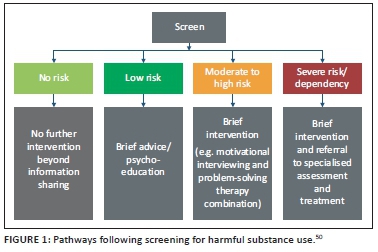
2.2.1.1 Screening: Screening people at risk for, or living with, HIV for harmful alcohol and/or drug use is crucial and can be performed in a myriad of settings including consulting rooms, emergency units, hospital wards and community settings (see Appendix 2). Screening tools such as the Alcohol, Smoking and Substance Involvement Screening Test (ASSIST)44 and Alcohol Use Disorders Identification Test (AUDIT) make use of risk categories determined by screening scores to help determine the ideal intervention strategy (Table 9). Additional alternative validated tools are listed in Appendix 2.
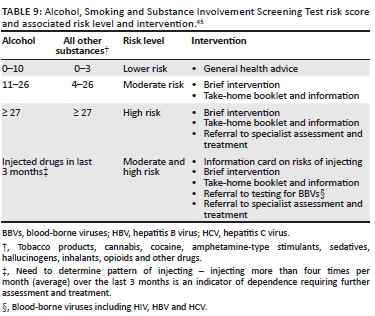
2.2.1.2 Brief interventions: A brief intervention is a short (time-limited), often opportunistic, patient-centred strategy, where a healthcare provider provides targeted information and/or advice to individuals during the course of other health activities such as routine outpatient review or HIV testing.45 The aim of the interaction is to increase insight and awareness of harmful substance use to facilitate a patient's motivation to modify risky behaviour. Brief interventions thus seek to reduce drug use and associated behaviours, which increase the risk of contracting or transmitting HIV, for example, risky sexual behaviour and unsafe drug injecting practices. There is little difference in the outcomes between longer, more intensive interventions and brief interventions; and brief interventions are practical, cost-effective and have a growing evidence base.46,47
Behavioural interventions, self-regulation coaching and psychosocial counselling can support HIV harm reduction and other HIV prevention objectives for people who use substances, whilst also contributing to longer-term and broader health and wellness goals.48,49 Brief interventions should be provided to people with moderate-to-high risk and above substance use. Clinical guides or steps for the use of common interventions follow, with details in Appendix 2.
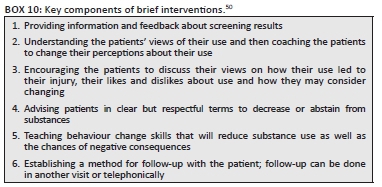

Elements of brief interventions may be aligned to the stages as outlined in Table 10. It is important to remain mindful of patient's social and economic context, an element some reviewers have flagged as not necessarily accounted for by strictly following these stages.
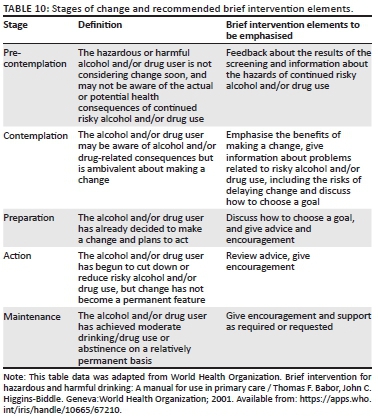
2.2.1.3 Referral for treatment: People with severe risk/dependency, as identified by a screening tool, require additional and more intensive support. If these are not provided by the person conducting the screening, then the patient should be referred for further assessment and management by a substance use disorder specialist at an appropriate facility.
2.3 HIV prevention
2.3.1 Condoms and lubricant
2.3.2 Pre- and post-exposure prophylaxis
2.3.3 Voluntary medical male circumcision
2.4 Harm reduction interventions
2.4.1 Needle-and-syringe services

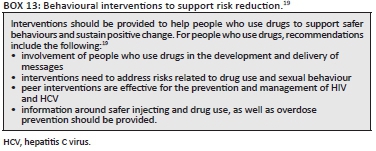

2.4.2 Opioid substitution therapy
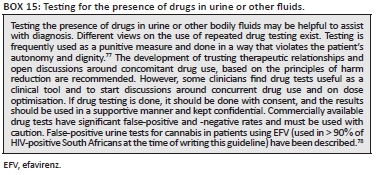
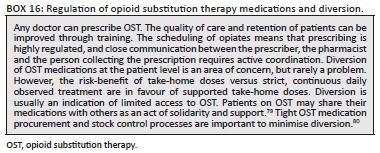
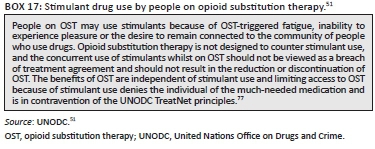

2.4.3 Overdose services
2.4.4 Emerging and ancillary interventions
Several additional interventions are important as part of comprehensive harm reduction. Some are briefly provided below, including (1) harm reduction for people who use stimulants, (2) drug consumption rooms and (3) drug checking services.
2.4.4.1 Harm reduction for people who use stimulants: Cocaine, methamphetamine (tik, ice), methcathinone (cat) and MDMA (ecstasy) are the most common unregulated stimulants seen in southern Africa, and methylphenidate is the most prescribed stimulant.
Simple harm reduction advice for people who use stimulants is to follow a few steps.
•Avoid the concurrent use of alcohol and cocaine. Cocaine use potentially compromises the cardiovascular system and is linked to several cardiovascular diseases; this risk increases with the concurrent use of alcohol.
•Rest: Sleep deprivation and stimulant use increase the chance of psychosis. People on stimulants often binge for days. People using stimulants should be encouraged to lie down in a dark space, with eyes close and relax for at least 3-4 h every 24 h.
•Hydrate: People using stimulants may be at risk of dehydration. People should be encouraged to drink 500 mL water per hour, especially if dancing.
•Eat: People using stimulants should be encouraged to eat something at least every 24 h, even if not hungry.
•Dental care: Sip water when the mouth is dry and brush teeth twice a day.
Other relevant harm reduction interventions include psychosocial support, condoms and lubricants (amphetamine-type stimulants can increase sex drive and risky sexual practice) and drug paraphernalia distribution (injecting and/or smoking kits that include mouth pieces for crack pipes), services for sexually transmitted infections, income generation and housing support. Substitution therapies for stimulant use disorders are under investigation.
2.4.4.2 Drug consumption rooms: Drug consumption rooms (also known as safe injecting facilities, medically supervised injecting sites or overdose prevention sites) are protected places for the hygienic consumption of drugs in a non-judgemental environment. They allow people to use drugs under medical supervision or in the presence of trained and equipped peers,89 enabling an immediate response to overdose and decreasing the transmission of blood-borne diseases through access to sterile injecting equipment and education on safe injection practices.90 Drug consumption rooms increase uptake of other health services and are an entry into care, for example, facilitating access to HIV, viral hepatitis, TB testing and treatment services and counselling.90 In 2018, 11 countries were operating drug consumption rooms across 117 sites.5 An overview of drug consumption rooms is available at: http://www.drugconsumptionroom-international.org.
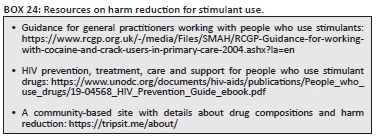
2.4.4.3 Drug-checking services: A means to check the quality and purity of drugs should be available to people who use drugs. This includes fixed site testing and on-the-spot testing options, the latter being mostly qualitative tests.91 For example, strips designed to identify fentanyl in drugs may help to prevent overdoses. People who use opioids can use the results of the test kit strip to inform their drug use (i.e. to use slowly, to reduce the volume of drug, to use in the company of others, to have a naloxone rescue kit nearby or not to use the substance). Test kits can be used on crushed pills or powders.92 Guidance around the use of fentanyl test strips is available at: https://harmreduction.org/issues/fentanyl.
Key points
•Harm reduction requires engaging with patients to identify immediate risks and develop means to reduce these.
•Screening, brief intervention and referral for treatment is an effective approach to detect and intervene in harmful substance use.
•Needle-and-syringe services are the cornerstone of HIV prevention for people who inject drugs and should be provided at all contacts with health services.
•People who inject drugs should be supported to return their used injecting equipment and locations for safe disposal of used equipment should be made widely available.
•Opioid substitution therapy is the most effective treatment for opioid use disorder. Effectiveness is maximised when patients are supported and provided with an optimal dose of medication. Voluntary psychosocial services can improve outcomes. Safety risks are greatest early on during treatment, and patients who are stable should be considered for take-home dosing. Treatment should be long term.
•Good supply chain and stock management are important to minimise diversion of opioid agonist medications.
•Opioid overdoses cause many deaths and are preventable. People likely to witness an opioid overdose should be trained to identify and respond to this, and access to naloxone should be maximised.
2.5 HIV testing, treatment and care
2.5.1 HIV testing and counselling
2.5.2 Antiretroviral therapy
2.5.3 Prevention of mother-to-child transmission of HIV
Key points
•People who use drugs should be informed of their rights to confidentiality and consent and their right to refuse HIV testing if they choose.
•Uptake and retention in care are improved where ART is integrated with OST when needed.
•Pregnant women living with HIV who are not on ART should be enrolled on an ART programme urgently.
•Needle-and-syringe programmes and other evidence-based harm reduction services should be offered to all people who use drugs, irrespective of their HIV status.
•All people who use drugs and who are found to be HIV-negative should be provided with risk reduction information and commodities tailored to their substance use (considering their patterns and type of substance, etc.) and sexual practices.
•People who use drugs and who test HIV-negative should test regularly (every 6 weeks to 3 months) depending on their risk profile.
•An individual with a discrepant HIV test result should be referred for re-testing in 14 days.
•If a person comes for HTS within 72 h after a potential exposure, then PEP should be considered52 (see section 'Pre- and post-exposure prophylaxis')
2.6 Prevention and management of coinfections and comorbidities
2.6.1 Tuberculosis services
2.6.2 Viral hepatitis services
2.6.3 Mental health services
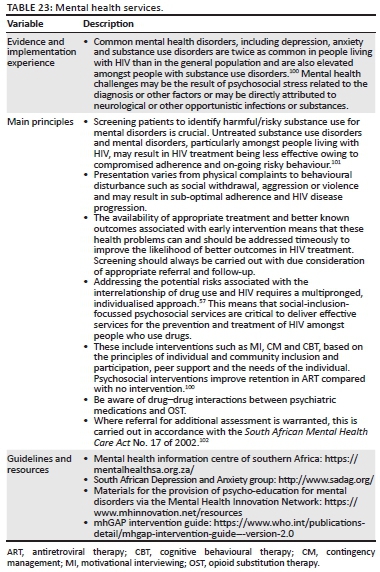
2.6.4 Sexual and reproductive health services
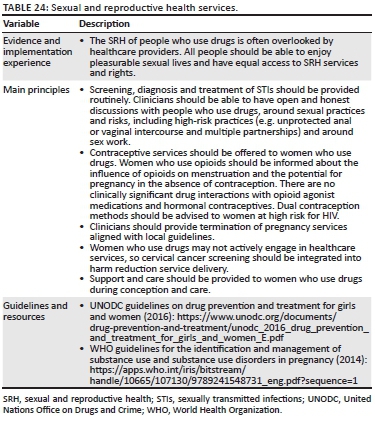
2.7 Critical enablers
2.7.1 Supportive law and policy
Clinicians, programme managers and policymakers should work together to support the decriminalisation of drug use, as well as sex work, to reduce health risks related to arrest, detention and incarceration and ensure the protection of rights.
Interventions and support to reduce drug dependence should ideally consist of a continuum of care, starting with early development strategies focusing on the delay of drug use and prevention strategies, moving to early-use interventions such as brief interventions and information. More intensive interventions should be reserved for people with dependencies that cause significant impairment.85 A supportive and effective continuum and continuity of care service requires supportive policies. The criminalisation of people who use drugs often disrupts the provision of a continuum of care, by seeing all drug use as a criminal act, thus disrupting the continuity of services through arrest and incarceration and accelerating the development of drug dependence.103,104 Considering the additional economic, health, social and psychological harms associated with the criminalisation, arrest and incarceration of people who use drugs, there should be a robust debate on the decriminalisation of the use of drugs and advocacy for the provision of services for incarcerated populations. The Southern African HIV Clinicians Society supports the decriminalisation of drug use: https://sahivsoc.org/Files/2019-06-03%20Drug%20Use%20%20Decrim%20statment.pdf
Clinicians should take on an advocacy role for: better care based on evidence for people who use drugs; human rights for people who use drugs; harm reduction approaches that include the activities described earlier, as well as access a safe supply of opioids (see the text Box 26 on safe supply). Clinicians should also advocate for the evaluation of current policies regarding illicit drug law and enforcement.
2.7.2 Countering stigma and discrimination
Clinicians and public health leaders should work with civil society organisations and networks of people who use drugs to monitor stigma and discrimination and advocate to change punitive legal and social norms. The development of a stigma index that includes people who use drugs and other people engaged in illegal and/or stigmatised practices could be developed to quantify stigma and measure changes over time.


Clinicians should ensure that the health services they provide are available, accessible and acceptable to people who use drugs.
Approaches to rendering services friendly to people who use drugs and other key populations:
•Ensuring adequate training of staff and develop supportive attitudes towards people who use drugs
•Integrating health services
•Providing services at times that suit patients
•Locating services strategically where patients congregate or transit
•Involving peers in the planning, promotion, delivery and monitoring of services
•Taking steps to ensure law enforcement does not interfere with access to services
2.7.3 Enabling community empowerment
Clinicians, public health leaders and civil society organisations can support the empowerment of people who use drugs by enabling their active participation in the planning and implementation of services, with a focus on peer education and training on safer drug use, harm reduction and broader issues relating to their rights and health.
2.7.4 Acting against violence
People who use drugs are at high risk for physical, sexual and psychological violence. This violence increases their risk for HIV and viral hepatitis and negatively affects their mental health. Many people who use drugs have been traumatised through their engagement with law enforcement and entry into the criminal justice system. Women who use drugs are at particularly high risk of violence and its effects.
Clinicians, public health leaders and civil society organisations should aim to prevent violence affecting people who use drugs, which can include engagement with law enforcement to sensitise them to the issues and their role to uphold the rights of all people.
The occurrence of violence should also be monitored and reported and mechanisms to access redress explored.
Clinicians should provide clinical care and initial psychological support to survivors of violence, with referral for additional support when needed. Processes following instances of rape should follow local guidelines.
There is strong evidence linking structural inequities to accessing health services with a higher risk of HIV infection, as well as continuing or everyday intimate partner- and gender-based violence.107,108 Structural inequities in access to services hold true particularly for people who use licit drugs in countries where drug use has been criminalised and where no harm reduction services exist. To address the concerns emerging from the many interacting aspects of violence, trauma and substance use, harm-reducing systems of care need to integrate with other primary healthcare services.109 Linking harm reduction services to services such as sexual and reproductive health (SRH) services, including sexually transmitted infection (STI) prevention services, and supportive primary care would allow for more effective harm reduction programming.
3. Special considerations
3.1 Young people who use drugs
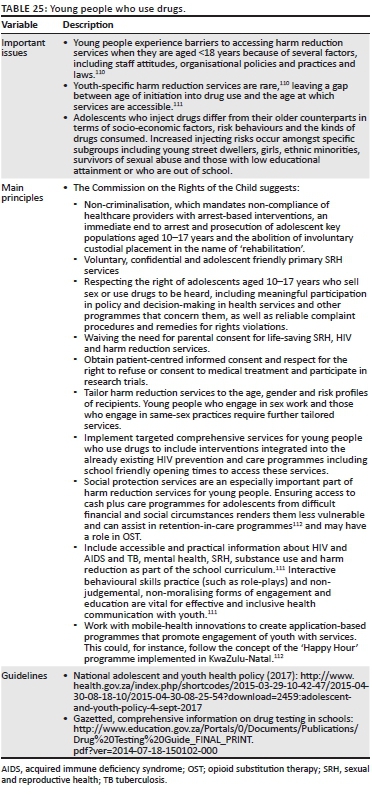
3.2 Women who use drugs
3.3 Substance use in the context of sexual encounters
3.4 Prison settings
4. Recommendations
This section summarises the key role of critical stakeholders in the delivery of harm reduction services in HIV, TB, viral hepatitis and related services.
5. Acknowledgements
Additional inputs received from Lize Weich, Tanya Venter, Johannes Hugo, Urvisha Bhoora, Magriet Spies, Rafaela Rigoni, Cara O'Conner, Julia Samuelson, Viriginia Macdonald, Michelle Rodolph, Shona Dalal, Nurain Tisaker and Shaheema Allie. Regional harm reduction case studies developed by Kunal Naik (PILS, Mauritius) and Bernice Apondi (VOCAL, Kenya).
Inputs from the guideline development workshop held in August 2019 are also included. Participants of the workshop included: Leora Casey, Andrew Gray, Harry Hausler, Signe Rotberga, Muhangwi Mulaudzi, Lauren Jankelowitz, Annette Verster, Busisiwe Msimanga-Radebe, Nontsikelelo Mpulo, Zukiswa Ngobo, Mpho Maraisane, Rogerio Phili, Kgalabi Ngako, Maria Sibanyoni, Yolanda Ndimande, Valencia Malaza, Johannes Hugo, Urvisha Bhoora and Cara O'Conner.
We extend our thanks to the external reviewers, including Julie Bruneau, Annette Verster, Kunal Naik, Nkereuwem William Ebiti and Ali Feizzadeh.
Competing interests
The authors confirm that no competing interests exist.
Authors' contributions
All authors contributed equally to this work.
Ethical consideration
This article followed all ethical standards for research without direct contact with human or animal subjects.
Funding information
No specific grant was received from any funding agency in the public, commercial or non-for-project sectors.
Data availability statement
Data sharing is not applicable to this article as no new data were created or analysed in this study.
Disclaimer
Specific recommendations provided here are intended only as a guide to clinical management, based on expert consensus and best current evidence. Treatment decisions for patients should be made by their responsible clinicians, with due consideration for individual circumstances. The most current version of this document should always be consulted.
The views and opinions expressed in this article are those of the authors and do not necessarily reflect the official position of any affiliated agency of the authors.
Glossary
References
1.Siegel R. Intoxication: The universal drive for mind-altering substances. Rochester: Park Street Press; 2005. [ Links ]
2.UNODC. World drug report 2019. Executive summary. Vienna: UNODC; 2019. [ Links ]
3.Transform Drug Policy Foundation. Count the costs. 50 years of the war on drugs. London: Transform Drug Policy Foundation, 2012; p. 1-16. [ Links ]
4.Scheibe A, Shelly S, Versfeld A, Howell S, Marks M. Safe treatment and treatment of safety: Call for a harm-reduction approach to drug-use disorders in South Africa. S Afr Health Rev. 2017;20:197-204. [ Links ]
5.Harm Reduction International. The global state of harm reduction 2018. 6th ed. London: Harm Reduction International; 2018. [ Links ]
6.Harm Reduction International. What is harm reduction? [homepage on the Internet]. [cited 2020 Mar 5]. Available from: https://www.hri.global/what-is-harm-reduction [ Links ]
7.Hawk M, Coulter RWS, Egan JE, et al. Harm reduction principles for healthcare settings. Harm Reduct J [serial online]. 2017 Dec 24;14(1):70. Available from: http://harmreductionjournal.biomedcentral.com/articles/10.1186/s12954-017-0196-4 [ Links ]
8.Zinberg N. Drug, set and setting: The basis for controlled intoxicant use. New Haven, CT: Yale University Press; 1984. [ Links ]
9.World Health Organization. ICD-11 for mortality and morbidity statistics. Geneva: WHO. [ Links ]
10.Waldo Zuardi A, Alexandre S. Crippa J, et al. A critical review of the antipsychotic effects of cannabidiol: 30 years of a translational investigation. Curr Pharm Des [serial online]. 2012 Sep 12;18(32):5131-5140. Available from: http://www.eurekaselect.com/openurl/content.php?genre=article&issn=1381-6128&volume=18&issue=32&spage=5131 [ Links ]
11.Brennan R, Wells JSG, Van Hout MC. The injecting use of image and performance-enhancing drugs (IPED) in the general population: A systematic review. Health Soc Care Community. 2017;25(5):1459-1531. https://doi.org/10.1111/hsc.12326 [ Links ]
12.Khine A, Mokwena K, Huma M, Fernandes L. Identifying the composition of street drug Nyaope using two different mass spectrometer methods. Afri J Drug Alcohol Stud. 2015;14(1):49-56. [ Links ]
13.Dada S, Harker N, Jodilee B, et al. April 2019 | phase 44. Cape Town: SA Medical Research Council; 2019. [ Links ]
14.Peltzer K, Phaswana-Mafuya N. Drug use among youth and adults in a population-based survey in South Africa. S Afr J Psychiatr. 2018;24(1):1-6. https://doi.org/10.4102/sajpsychiatry.v24i0.1139 [ Links ]
15.Dada S, Harker-Burnhams N, Erasmus J, et al. SACENDU. Monitoring alcohol, tobaccoe and other drug use trends (South Africa): July-December 2018. Vol. Phase 45. Cape Town: Medical Research Council; 2018. [ Links ]
16.Olashore AA, Ogunwobi O, Totego E, Opondo PR. Psychoactive substance use among first-year students in a Botswana University: Pattern and demographic correlates. BMC Psychiatry. 2018;18(1):1-9. https://doi.org/10.1186/s12888-018-1844-2 [ Links ]
17.UNODC. World drug report 2019 data [homepage on the Internet]. World drug report 2019. Vienna; 2019 [cited 2019 Sep 03]. Available from: https://wdr.unodc.org/wdr2019/index.html [ Links ]
18.United Nations. Single convention on narcotic drugs [homepage on the Internet]. Final act of the united nations conference for the adoption of a single convention on narcotic drugs. Vienna: United Nations, 1961; p. 44. Available from: https://www.unodc.org/pdf/convention_1961_en.pdf [ Links ]
19.World Health Organization. Consolidated guidelines on HIV prevention, diagnosis, treatment and care for key populations. Geneva: World Health Organization; 2016. [ Links ]
20.Deiss RG, Rodwell TC, Garfein RS. Tuberculosis and illicit drug use: Review and update. Clin Infect Dis. 2009 Jan;48(1):72-82. https://doi.org/10.1086/594126 [ Links ]
21.Viviers PJ, Van Zyl-Smit RN.Chronic obstructive pulmonary disease - Diagnosis and classification of severity. S Afr Med J. 2015;105(9):786-788. https://doi.org/10.7196/SAMJnew.8421 [ Links ]
22.Burhan H, Young R, Byrne T, et al. Screening heroin smokers attending community drug services for COPD. Chest. 2019;155(2):279-287. https://doi.org/10.1016/j.chest.2018.08.1049 [ Links ]
23.UNAIDS. Health, rights and drugs. Harm reduction, decriminalization and zero discrimination for people who use drugs. Geneva: Joint United Nations Programme on HIV/AIDS; 2019. [ Links ]
24.Teodoro E, Boothe M, Baltazar C, et al. Urgent need for harm-reduction interventions in Mozambique: Results from the integrated bio-behavioral survey among people who inject drugs. In: IAS 2015. Vancouver; 2015. p. Presentation. [ Links ]
25.University of California San Francisco, Anova Health Institute, National Institute for Communicable Diseases. Brief report of the tipval study: An integrated bio-behavioral surveillance survey among people who inject drugs. San Francisco, CA: University of California San Francisco; 2018. [ Links ]
26.Scheibe A, Young K, Moses L, et al. Understanding hepatitis B, hepatitis C and HIV among people who inject drugs in South Africa: Findings from a three-city cross-sectional survey. Harm Reduct J. 2019;16(28):1-11. https://doi.org/10.1186/s12954-019-0298-2 [ Links ]
27.Dannatt L, Cloete KJ, Kidd M, Weich L. Frequency and correlates of comorbid psychiatric illness in patients with heroin use disorder admitted to Stikland Opioid Detoxification Unit, South Africa. S Afr J Psychiatr. 2014;20(3):77. https://doi.org/10.4102/sajpsychiatry.v20i3.540 [ Links ]
28.Morgan N, Daniels W, Subramaney U. A prospective observational study of heroin users in Johannesburg, South Africa: Assessing psychiatric comorbidities and treatment outcomes. Compr Psychiatr. 2019 Oct;95:152137. https://doi.org/10.1016/j.scs.2019.101770 [ Links ]
29.Global Commission on Drug Policy. Classification of psychoactive substances: When science was left behind. Geneva: Global Commission on Drug Policy, 2019; p. 55. [ Links ]
30.Van Amsterdam J, Nutt D, Phillips L, Van den Brink W. European rating of drug harms. J Psychopharmacol [serial online]. 2015 Jun;29(6):655-660. Available from: http://journals.sagepub.com/doi/10.1177/0269881115581980 [ Links ]
31.Shelly S, Broughton I, Mcbide A, et al. Every single person looks at us bad. Cape Town: South African Network of People Who Use Drugs, 2017; p. 1-43. [ Links ]
32.Beyrer C, Malinowska-Sempruch K, Kamarulzaman A, Strathdee SA. 12 Myths about HIV/AIDS and people who use drugs. Lancet. 2010;376(9737):208-211. https://doi.org/10.1016/S0140-6736(10)61005-7 [ Links ]
33.Buchanan J. Understanding problematic drug use: A medical matter or a social issue? Br J Community Justice. 2006;4(2):47-61. [ Links ]
34.Ndimbii JN, Guise A, Ayon S, Kalama M, McLean S, Rhodes T. Implementing needle and syringe programmes in Kenya: Changes, opportunities and challenges in HIV prevention. Afr J Drug Alcohol Stud. 2015;14(2):95-103. [ Links ]
35.Mauritian Ministry of Health and Quality of Life. Statistics on HIV/AIDS. Port Louis, Government of Mauritius; 2015. [ Links ]
36.Police Force. Arrest rates 2007-2012. Port Louis: Mauritian Ministry of Health and Quality of Health; 2013. [ Links ]
37.Canadian Network on Hepatitis C Blueprint Writing Committee and Working Groups. Blueprint to inform hepatitis C elimination efforts in Canada. Montreal: Canadian Network on Hepatitis C, 2019; p. 23. [ Links ]
38.Kelly JF, Saitz R, Wakeman S. Language, substance use disorders, and policy: The need to reach consensus on an 'Addiction-ary'. Alcohol Treat Q [serial online]. 2016 Jan 2;34(1):116-123. Available from: http://www.tandfonline.com/doi/full/10.1080/07347324.2016.1113103 [ Links ]
39.Nyblade L, Stockton MA, Giger K, et al. Stigma in health facilities: Why it matters and how we can change it. BMC Med. 2019;17(1):1-15. https://doi.org/10.1186/s12916-019-1256-2 [ Links ]
40.INPUD. Statement and position paper on language, inclusivity and discrimination [homepage on the Internet]. London: International Network of People who Use Drugs, 2011; p. 1-6. Available from: http://www.inpud.net/INPUD_Statement_Position_Paper_on_Language_Identity_Inclusivity_Discrimination_Nov2011.pdf [ Links ]
41.ARASA. 'Don't treat us as outsiders'. Drug policy and the lived experiences of people who use drugs in Southern Africa. Windhoek: AIDS and Rights Alliance for southern Africa; 2019. [ Links ]
42.Govender RD, Schlebusch L. A suicide risk screening scale for HIV-infected persons in the immediate post-diagnosis period. South Afr J HIV Med [serial online]. 2013 Jun 4;14(2):58-63. Available from: https://sajhivmed.org.za/index.php/hivmed/article/view/79 [ Links ]
43.Agerwala SM, McCance-Katz EF. Integrating Screening, Brief Intervention, and Referral to Treatment (SBIRT) into clinical practice settings: A brief review. J Psychoactive Drugs [serial online]. 2012 Sep 1;44(4):307-317. Available from: https://www.tandfonline.com/doi/full/10.1080/02791072.2012.720169 [ Links ]
44.WHO. The ASSIST project - Alcohol, smoking and substance involvement screening test [homepage on the Internet]. [cited 2019 Oct 15]. Available from: https://www.who.int/substance_abuse/activities/assist/en/ [ Links ]
45.Humeniuk R, Henry-Edwards S, Ali R, Poznyak V, Monteiro MG, World Health Organization. The ASSIST-linked brief intervention for hazardous and harmful substance use: A manual for use in primary care / prepared by R. HumeniukƯ [et al.] [homepage on the Internet]. Geneva: World Health Organization, 2010; 40p. Available from: https://apps.who.int/iris/handle/10665/44321 [ Links ]
46.Van Der Westhuizen C, Myers B, Malan M, et al. Implementation of a screening, brief intervention and referral to treatment programme for risky substance use in South African emergency centres: A mixed methods evaluation study. PLoS One. 2019;14(11):1-20. https://doi.org/10.1371/journal.pone.0224951 [ Links ]
47.Beyer F, Lynch E, Kaner E. Brief interventions in primary care: An evidence overview of practitioner and digital intervention programmes. Curr Addict Reports. 2018;5(2):265-273. https://doi.org/10.1007/s40429-018-0198-7 [ Links ]
48.Malta M, Magnanini MMF, Strathdee SA, Bastos FI. Adherence to antiretroviral therapy among HIV-infected drug users: A meta-analysis. AIDS Behav [serial online]. 2010 Aug 20;14(4):731-747. Available from: http://link.springer.com/10.1007/s10461-008-9489-7 [ Links ]
49.Colfax G, Santos G-M, Chu P, et al. Amphetamine-group substances and HIV. Lancet [serial online]. 2010 Aug;376(9739):458-474. Available from: https://linkinghub.elsevier.com/retrieve/pii/S0140673610607532 [ Links ]
50.SAHMSA. Screening, Brief Intervention and Referral to Treatment (SBIRT) in Behavioral healthcare. Rockville; Substance Abuse and Mental Health Services Administration; 2011. [ Links ]
51.UNODC, WHO, UNAIDS. HIV prevention, treatment, care and support for people who use stimulant drugs. Vienna: United Nations Office on Drugs and Crime; 2019. [ Links ]
52.UNODC, INPUD, UNAIDS, et al. Implementing comprehensive HIV and HCV programmes with people who inject drugs. Practical guidance for collaborative inteventions. IDUIT. Vienna: United Nations Office on Drugs and Crime, 2017; p. 1-175. [ Links ]
53.Wodak A, Cooney A. Do needle syringe programs reduce HIV infection among injecting drug users: a comprehensive review of the international evidence. Subst Use Misuse. 2006;41(6-7):777-813. https://doi.org/10.1080/10826080600669579 [ Links ]
54.UNODC, WHO, UNAIDS. WHO, UNODC, UNAIDS Technical Guide for countries to set targets for universal access to HIV prevention, treatment and care fro injecting drug users - 2012 Revision. Vienna: United Nations Office on Drugs and Crime; 2012. [ Links ]
55.Kwon JA, Anderson J, Kerr CC, et al. Estimating the cost-effectiveness of needle-syringe programs in Australia. AIDS. 2012;26(17):2201-2210. https://doi.org/10.1097/QAD.0b013e3283578b5d [ Links ]
56.Wodak A, Cooney A. Effectiveness of sterile needle and syringe programmes. Int J Drug Policy. 2005 Dec;16(January):31-44. https://doi.org/10.1016/j.drugpo.2005.02.004 [ Links ]
57.Degenhardt L, Mathers B, Vickerman P, Rhodes T, Latkin C, Hickman M. Prevention of HIV infection for people who inject drugs: Why individual, structural, and combination approaches are needed. Lancet [serial online]. 2010 Jul 24 [cited 2012 Mar 14];376(9737):285-301. Available from: http://www.ncbi.nlm.nih.gov/pubmed/20650522 [ Links ]
58.Hunt N, Ashton M, Lenton S, Mitcheson L, Nelles B. A review of the evidence-base for harm reduction approaches to drug use. 2020 Oct 8. Available from: https://www.hri.global/files/2010/05/31/HIVTop50Documents11.pdf [ Links ]
59.World Health Organization. Effectiveness of sterile needle and syringe programming in reducing HIV/AIDS among injecting drug users. Geneva: World Health Organization; 2004. [ Links ]
60.World Health Organization. Global hepatitis report, 2017 [homepage on the Internet]. Geneva: World Health Organization, 2017; p. 62. Available from: http://www.who.int/hepatitis [ Links ]
61.Beletsky L, Agrawal A, Moreau B, Kumar J, Weiss-Laxer N, Heimer R. Can Police training help align law enforcement and HIV prevention ? Preliminary evidence from the field. Am J Public Health. 2011;101(11):2012-2015. https://doi.org/10.2105/AJPH.2011.300254 [ Links ]
62.Cepeda JA, Beletsky L, Sawyer A, et al. Occupational safety in the age of the opioid crisis: Needle stick injury among Baltimore Police. J Urban Heal. 2017;94(March 2012):100-103. https://doi.org/10.1007/s11524-016-0115-0 [ Links ]
63.Davis CS, Johnston J, Zerden LDS, Clark K, Castillo T, Childs R. Attitudes of North Carolina law enforcement officers toward syringe decriminalization. Drug Alcohol Depend. 2014;1(144):265-269. https://doi.org/10.1016/j.drugalcdep.2014.08.007 [ Links ]
64.Fernandes RM, Cary M, Duarte G, et al. Effectiveness of needle and syringe Programmes in people who inject drugs - An overview of systematic reviews. BMC Public Health. 2017;17(1):1-15. https://doi.org/10.1186/s12889-017-4210-2 [ Links ]
65.De Montigny L, Vernez Moudon A, Leigh B, Young K. Assessing a drop box programme: A spatial analysis of discarded needles. Int J Drug Policy [serial online]. 2010 May;21(3):208-214. Available from: https://linkinghub.elsevier.com/retrieve/pii/S0955395909001108 [ Links ]
66.Klein SJ, Candelas AR, Cooper JG, et al. Increasing safe syringe collection sites in New York State. Public Health Rep [serial online]. 2008 Jul;123(4):433-440. Available from: http://journals.sagepub.com/doi/10.1177/003335490812300404 [ Links ]
67.Riley ED, Kral AH, Stopka TJ, Garfein RS, Reuckhaus P, Bluthenthal RN. Access to sterile syringes through San Francisco pharmacies and the association with HIV risk behavior among injection drug users. J Urban Heal [serial online]. 2010 Jul 5;87(4):534-542. Available from: http://link.springer.com/10.1007/s11524-010-9468-y [ Links ]
68.Tookes HE, Kral AH, Wenger LD, et al. A comparison of syringe disposal practices among injection drug users in a city with versus a city without needle and syringe programs. Drug Alcohol Depend [serial online]. 2012 Jun;123(1-3):255-259. Available from: https://linkinghub.elsevier.com/retrieve/pii/S0376871611005229 [ Links ]
69.Aitken C, Moore D, Higgs P, Kelsall J, Kerger M. The impact of a police crackdown on a street drug scene: Evidence from the street. Int J Drug Policy. 2002;13:189-198. https://doi.org/10.1016/S0955-3959(02)00075-0 [ Links ]
70.Luisa Mittal M, Beletsky L, Patiño E, et al. Prevalence and correlates of needle-stick injuries among active duty police officers in Tijuana, Mexico. J Int AIDS Soc [serial online]. 2016;19(4 (Suppl 3)):1-7. Available from: http://www.jiasociety.org/index.php/jias/article/view/20874 [ Links ]
71.Strathdee SA, Hallett TB, Bobrova N, et al. HIV and risk environment for injecting drug users: the past, present, and future. Lancet [serial online]. 2010 Jul 24 [cited 2012 Mar 9];376(9737):268-284. Available from: http://www.ncbi.nlm.nih.gov/pubmed/20650523 [ Links ]
72.Latypov A, Bidordinova A, Khachatrian A. Opioid substitution therapy in Eurasia: How to increase the access and improve the quality. IDPC Briefing Paper. London: International Drug Policy Consortium, 2012; p. 1-19. [ Links ]
73.WHO. WHO guidance on the prevention of viral hepatitis B and C among people who inject drugs. Geneva: World Health Organization; 2012. [ Links ]
74.WHO. Guidelines for the psychosocially assisted pharmacological treatment of opioid dependence. Geneva: World Health Organization; 2009. [ Links ]
75.Bruneau J, Ahamad K, Goyer MÈ, et al. Management of opioid use disorders: A national clinical practice guideline. CMAJ. 2018;190(9):E247-E257. https://doi.org/10.1503/cmaj.170958 [ Links ]
76.American Psychiatric Association. Diagnostic and statistical manual of mental disorders. 5th ed. Washington, DC: American Psychiatric Association; 2013. [ Links ]
77.Rothstein MA. Drug testing in the workplace: The challenge to employment relations and employment law. Chic Kent Law Rev. 1987;63(3):684-743. [ Links ]
78.Oosthuizen NM, Laurens JB. Efavirenz interference in urine screening immunoassays for tetrahydrocannabinol. Ann Clin Biochem An Int J Biochem Lab Med [serial online]. 2012 Mar 1;49(2):194-196. Available from: http://acb.sagepub.com/lookup/doi/10.1258/acb.2011.011118 [ Links ]
79.Harris M, Rhodes T. Methadone diversion as a protective strategy: The harm reduction potential of 'generous constraints'. Int J Drug Policy. 2013;24(6):e43-e50. https://doi.org/10.1016/j.drugpo.2012.10.003 [ Links ]
80.Eurpean Monitoring Centre for Drugs and Drug Addiction. Strategies to prevent diversion of opioid substitution treatment medications. LIsbon: Eurpean Monitoring Centre for Drugs and Drug Addiction, 2016; p. 9. [ Links ]
81.Weich L, Nowbath H, Flegar S, et al. South African guidelines for the management of opioid dependence. Updated 2013. Pretoria: South African Addiction Medicine Society; 2013. [ Links ]
82.Alford DP, Compton P, Samet JH. Acute pain management for patients receiving maintenance methadone or buprenorphine therapy. Ann Intern Med. 2006;144(2):127-134. https://doi.org/10.7326/0003-4819-144-2-200601170-00010 [ Links ]
83.United Nations Office on Drugs and Crime, World Health Organization. Opioid overdose: Preventing and -reducing opioid overdose mortality. Discussion paper. New York, NY: United Nations; 2013. [ Links ]
84.WHO. Community management of opioid overdose. Geneva: World Health Organization, 2014; p. 374-395. [ Links ]
85.WHO, MHGAP. mhGAP intervention guide for mental, neurological and substance use disorders in non-specialized health settings. Version 2.0. Geneva: World Health Organization; 2016. [ Links ]
86.Ford C. Guidance for working with cocaine and crack users in primary care [homepage on the Internet]. London: Royal College of General Practitioners, 2004; p. 39. Available from: www.smmgp.co.uk [ Links ]
87.Petry NM, Stitzer ML. Contingency management: Using motivational incentives to improve drug abuse treatment. Yale Univ Psychother Dev Cent Train Ser. 2002;(6):1-55. [ Links ]
88.Department of Health. Standard treatment guidelines and essential medicines list for South Africa. Hospital level. Adults. Third. Pretoria: National Department of Health; 2015. [ Links ]
89.DeBeck K, Wood E, Zhang R, Tyndall M, Montaner J, Kerr T. Police and public health partnerships: Evidence from the evaluation of Vancouver's supervised injection facility. Subst Abuse Treat Prev Policy [serial online]. 2008;3(1):11. Available from: http://www.doaj.org/doaj?func=abstract&id=259996 [ Links ]
90.Belackova V, Salmon A. Overview of International Literature. Supervised injecting facilitiesa nd drug consumption rooms. Sydney: United Medically Supervised Injecting Centre; 2017. [ Links ]
91.Rigoni R, Breeksema J, Woods S. Speed limits: Harm reduction for people who use stimulants [homepage on the Internet]. Amsterdam: Mainline, 2018; p. 144. Available from: http://fileserver.idpc.net/library/Mainline_REPORT_complete.pdf [ Links ]
92.Harm reduction coalition. Fentanyl [homepage on the Internet]. Fentanyl test stips. [cited 2019 Oct 22]. Available from: https://harmreduction.org/issues/fentanyl/ [ Links ]
93.Frasca T, Ibitoye M, Dolezal C, Carballo A, Studies B. testing increases if other STIs can be detected. 2018;21(2):501-504. [ Links ]
94.Nguyen VTT, Phan HTT, Kato M, et al. Community-led HIV testing services including HIV self-testing and assisted partner notification services in Vietnam: Lessons from a pilot study in a concentrated epidemic setting. J Int AIDS Soc. 2019;22(S3):40-48. https://doi.org/10.1002/jia2.25301 [ Links ]
95.Wolfe D, Carrieri MP, Shepard D. Treatment and care for injecting drug users with HIV infection: A review of barriers and ways forward. Lancet [serial online]. 2010 Jul;376(9738):355-366. Available from: https://linkinghub.elsevier.com/retrieve/pii/S014067361060832X [ Links ]
96.Tahseen S, Shahnawaz H, Riaz U, et al. Systematic case finding for tuberculosis in HIV-infected people who inject drugs: Experience from Pakistan. Int J Tuberc Lung Dis. 2018;22(2):187-193. https://doi.org/10.5588/ijtld.17.0390 [ Links ]
97.Gupta A, Mbwambo J, Mteza I, et al. Active case finding for tuberculosis among people who inject drugs on methadone treatment in Dar es Salaam, Tanzania. Int J Tuberc Lung Dis [serial online]. 2014 Jul 1;18(7):793-798. Available from: http://openurl.ingenta.com/content/xref?genre=article&issn=1027-3719&volume=18&issue=7&spage=793 [ Links ]
98.World Health Organization. Integrating collaborative TB and HIV services within a comprehensive package of care for people who inject drugs: Consolidated guidelines [homepage on the Internet]. Geneva: World Health Organization; 2016. Available from: www.who.int/about/licensing/copyright_form/en/index.html [ Links ]
99.World Health Organization (WHO). Guidelines for the care and treatment of persons diagnosed with chronic hepatitis c virus infection. Geneva: World Health Organization; 2018. [ Links ]
100.RAND Health. Mental health and substance abuse issues among people with HIV. Lessons from HCSUS. Santa Monica, CA: RAND corporation; 2007. [ Links ]
101.Kader R, Govender R, Seedat S, Koch JR, Parry C. Understanding the impact of hazardous and harmful use of alcohol and/or other drugs on ARV adherence and disease progression. PLoS One. 2015;10(5):1-12. https://doi.org/10.1371/journal.pone.0125088 [ Links ]
102.South African Government. Mental Health Care Act No 17 of 2002 [homepage on the Internet]. Volume 469. Government Gazette. Cape Town: South African Government; 2002. Available from: http://www.nsw.gov.au/sites/default/files/Government_Gazette_2_December.pdf#page=15 [ Links ]
103.Maher L, Dixon TC. Collateral damage and the criminalisation of drug use. Lancet HIV [serial online]. 2017 Aug;4(8):e326-e327. Available from: https://linkinghub.elsevier.com/retrieve/pii/S2352301817300711 [ Links ]
104.Jelsma M. UN Common Position on drug policy - Consolidating system-wide coherence. London: International Drug Policy Consortium, 2019; p. 1-36. [ Links ]
105.Drug Policy Alliance. Drug decriminalization in portugal learning from a health and human-centered approach [homepage on the Internet]. New York, NY: Drug Policy Alliance; 2018. Available from: www.drugpolicy.org3 [ Links ]
106.Alliance for Healthier Communities. Safe supply. Harm reduction. 2020 Oct 8. Available from: https://www.allianceon.org/Harm-Reduction [ Links ]
107.Shannon K, Kerr T, Allinott S, Chettiar J, Shoveller J, Tyndall MW. Social and structural violence and power relations in mitigating HIV risk of drug-using women in survival sex work. Soc Sci Med. 2008;66(4):911-921. https://doi.org/10.1016/j.socscimed.2007.11.008 [ Links ]
108.Bungay V, Johnson JL, Varcoe C, Boyd S. Women's health and use of crack cocaine in context: Structural and 'everyday' violence. Int J Drug Policy. 2010;21(4):321-329. https://doi.org/10.1016/j.drugpo.2009.12.008 [ Links ]
109.Poole N, Urquhart C, Talbot C. Women-centred harm reduction reducing harms across social determinants of women' s health [homepage on the Internet]. Vancouver: British Columbia Centre of Excellence for Women's Health; 2010. Available from: http://www.bccewh.bc.ca/publications-resources/documents/GenderingNatFrameworkWomencentredHarmReduction.pdf [ Links ]
110.International HIV/AIDS Alliance, Harm Reduction International, Youth RISE. Tool for harm reduction service providers preparing for work with children and young people who inject. London: International HIV/AIDS Alliance; 2015. [ Links ]
111.Krug A, Hildebrand M, Sun N. 'We don't need services. We have no problems': Exploring the experiences of young people who inject drugs in accessing harm reduction services. J Int AIDS Soc. 2015;18(2):71-77. https://doi.org/10.7448/IAS.18.2.19442 [ Links ]
112.National Department of Health. National adolescent & youth health policy. Pretoria: South African National Department of Health, 2017; p. 31. [ Links ]
113.Department of Basic Education. Guide to drug testing in South African schools [homepage on the Internet]. Pretoria; 2013. Available from: http://www.education.gov.za/Portals/0/Documents/Publications/Drug_Testing Guide_FINAL_PRINT.pdf?ver=2014-07-18-150102-000 [ Links ]
114.Auerbach JD, Smith LR. Theoretical foundations of research focused on HIV prevention among substance-involved women: A review of observational and intervention studies. J Acquir Immune Defic Syndr [serial online]. 2015 Jun 1;69 Suppl 2(3):S146-S154. Available from: http://www.ncbi.nlm.nih.gov/pubmed/25978481 [ Links ]
115.UNODC. Were you really raped, or did you just not get paid? A needs assessment of women who use drugs in fourn cities in South Africa. Pretoria: United Nations Office on Drugs and Crime; 2019. [ Links ]
116.UNODC, UNWOMEN, WHO, INPUD. Women who inject drugs and HIV: Addressing specific needs Issue summary: The Key reasons and unique challenges. Policy brief. Vienna: UNODC; 2014. [ Links ]
117.International AIDS Society. Women who inject drugs: Overlooked, yet visible. Geneva: International AIDS Society; 2019. p. 1-12. [ Links ]
118.Van Houten JP, Rudd RA, Ballesteros MF, Mack KA. Drug overdose deaths among women aged 30-64 years - United States, 1999-2017. MMWR Morb Mortal Wkly Rep [serial online]. 2019 Jan 11;68(1):1-5. Available from: http://www.cdc.gov/mmwr/volumes/68/wr/mm6801a1.htm?s_cid=mm6801a1_w [ Links ]
119.South African National AIDS Council, South African Government. South African National LGBTI HIV Plan 2017-2022. Pretoria: South African National AIDS Council; 2017. [ Links ]
120.UNDP, IRGT, UNFPA, et al. Implementing comprehensive HIV and STI programmes with transgender people. New York, NY: United Nations Development Program; 2016. [ Links ]
121.Pufall EL, Kall M, Shahmanesh M, et al. Sexualized drug use ('chemsex') and high-risk sexual behaviours in HIV-positive men who have sex with men. HIV Med. 2018;19(4):261-270. https://doi.org/10.1111/hiv.12574 [ Links ]
122.UNAIDS. The gap report. Geneva: Joint United Nations Program on HIV/AIDS; 2014. [ Links ]
123.Skager R. Beyond zero tolerance: A reality-based approach to drug education & school discipline. New York, NY: Drug Policy Alliance; 2013. [ Links ]
124.Els C, Jackson TD, Milen MT, Kunyk D, Straube S. Random drug and alcohol testing for preventing injury in workers. Cochrane Database Syst Rev [serial online]. 2018 Jan 12; Available from: http://doi.wiley.com/10.1002/14651858.CD012921 [ Links ]
125.Rigoni R. Reducing harms in the work environment: guidelines for employing people who use drugs in harm reduction programs in South Africa. Amsterdam: Mainline. [ Links ]
126.White WL. Recovery / remission from substance use disorders an analysis of reported outcomes in 415 scientific reports, 1868-2011. Philadelphia: Great Lakes Addiction Technology Transfer Centre; 2012. [ Links ]
127.Lopez-Quintero C, Hasin D, Perez de los Cabos J, et al. Probability and predictors of remission from lifetime nicotine, alcohol, cannabis, or cocaine dependence: Results from the national epidemiologic survey on alcohol and related conditions. Addiction. 2011;106(3):657-669. https://doi.org/10.1111/j.1360-0443.2010.03194.x [ Links ]
128.O'Brien C. Addiction and dependence in DSM-V. Addiction [serial online]. 2011 May;106(5):866-867. Available from: https://www.ncbi.nlm.nih.gov/pmc/articles/PMC3624763/pdf/nihms412728.pdf [ Links ]
129.National Institute on Drug Abuse. Resource guide screening for drug use in general medical settings: A resource guide for providers [homepage on the Internet]. Resource guide. Bethesda, MD: National Institute on Drug Abuse; 2012. Available from: https://www.drugabuse.gov/publications/resource-guide-screening-drug-use-in-general-medical-settings/nida-quick-screen [ Links ]
130.Ewing JA. Detecting alcoholism. JAMA [serial online]. 1984 Oct 12;252(14):1905. Available from: http://jama.jamanetwork.com/article.aspx?doi=10.1001/jama.1984.03350140051025 [ Links ]
131.Russell M. New assessment tools for drinking in pregnancy: T-ACE, TWEAK, and others. Alcohol Health Res World. 1994;18(1):55-61. [ Links ]
132.World Health Organization. Brief intervention: The ASSIST-linked brief intervention for hazardous and harmful substance use: Manual for use in primary care. Geneva: World Heal Organization, 2010; p. 46. [ Links ]
133.National Department of Health. Symptom-based integrated approach to the adult in primary care: 2019/2020 [homepage on the Internet]. Pretoria; 2019. Available from: https://www.knowledgehub.org.za/elibrary/adult-primary-care-apc-guide-20192020 [ Links ]
134.Breuer E, Stoloff K, Myer L, Seedat S, Stein DJ, Joska JA. The Validity of the Substance Abuse and Mental Illness Symptom Screener (SAMISS) in people living with HIV/AIDS in primary HIV care in Cape Town, South Africa. AIDS Behav [serial online]. 2014 Jun 23;18(6):1133-1141. Available from: http://link.springer.com/10.1007/s10461-014-0698-y [ Links ]
135.Sorsdahl K, Stein DJ, Corrigall J, et al. The efficacy of a blended motivational interviewing and problem solving therapy intervention to reduce substance use among patients presenting for emergency services in South Africa: A randomized controlled trial. Subst Abuse Treat Prev Policy [serial online]. 2015 Dec 14;10(1):46. Available from: http://substanceabusepolicy.biomedcentral.com/articles/10.1186/s13011-015-0042-1 [ Links ]
136.Bluthenthal RN, Simpson K, Ceasar RC, Zhao J, Wenger L, Kral AH. Opioid withdrawal symptoms, frequency, and pain characteristics as correlates of health risk among people who inject drugs. Drug Alcohol Depend [serial online]. 2020 Jun;211:107932. Available from: https://linkinghub.elsevier.com/retrieve/pii/S0376871620300971 [ Links ]
137.South African National Department of Health. National guidelines for the management of viral hepatitis. Pretoria: National Department of Health; 2019. [ Links ]
138.British Columbia Centre on Substance Use, B.C Ministry of Health, B.C. Ministry of Mental Health and Addictions & Perinatal Services. A guideline for the clinical management of opioid use disorder - Pregnancy supplement. Vancouver: B.C. Ministry of Health; 2018. [ Links ]
139.Nezu AM, Nezu CM, D'Zurilla TJ. Problem-solving therapy. A treatment manual. New York, NY: Springer Publishing Company; 2012. [ Links ]
 Correspondence:
Correspondence:
Andrew Scheibe
andrew.scheibe@gmail.com
Received: 28 Aug. 2020
Accepted: 28 Aug. 2020
Published: 17 Dec. 2020
Appendix 1: Common myths about drugs use
Appendix 2: Assessing patients during first and subsequent encounters
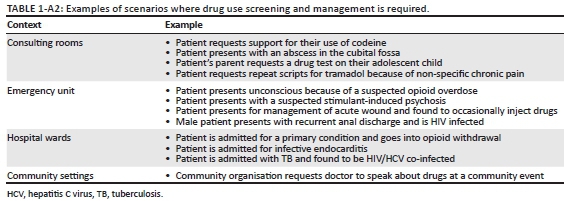
Appendix 3: Guidelines for opioid substitution therapy
Dosing
Optimal dosing is important for full benefits of opioid substitution therapy (OST) to be realised. Opioid substitution therapy should be used for as long as a patient requires it (at minimum, 1 year). The risk of other opioid use is decreased with longer duration of OST.
•Supervised dosing
It is recommended initially for patients starting on methadone or buprenorphine. Continuation of supervised dosing should be assessed once the patient has been on a stable maintenance dose for approximately 3-6 months and should be individualised.
Daily dosing may need to continue for patients with limited support structures or for those living in areas where safe storage and access are limited.
•Take-home dosing
Allowing take-home doses is an important component of patient autonomy and ease-of-use, which enhances retention, the strongest determinant of positive outcomes.
Take-home dosing allows for patients to focus on other areas of their life because they do not have to spend excessive time and resources to access daily dosing.
Take-home dosing can initially start over weekends, moving to longer periods of time.
Discussions with patients and their support network should include available options.
Community pharmacies are an option for dosing outside of health facilities.
Buprenorphine (± naloxone) take-home dosing is easier (if in tablet form) and is generally safer than methadone as it has a lower overdose risk.
Opioid substitution therapy projects that have used methadone report few overdose-related deaths and limited diversion.80
Facilitate a discussion of processes that will be taken if diversion/selling of OST medications becomes apparent, including taking a restorative justice approach and maximising patient safety.
Supervised dosing should be reinstituted if the clinician has safety concerns or concerns around diversion (e.g. missed appointments, intoxicated while attending appointments, changes in clinical or social situation).
Regular monitoring of patients
•Once on a stable dose
Monthly assessment by a doctor, re-prescribing methadone/buprenorphine75
Quarterly assessment of medical and social history
Repeat assessment of substance use history, using the same tools used at screening (in a non-judgemental manner) - providing counselling and support in relation to outcomes
Offer HIV and hepatitis C virus (HCV) testing quarterly; assess antiretroviral therapy (ART) adherence as needed
Perform regular tuberculosis (TB) screening (assess weight loss, cough, fever and night sweats)
Patients who report ongoing injecting, or injecting in the previous year, should have regular HCV testing.
Retention and support for adherence
Psychosocial interventions aim to support retention within OST programmes. A broad range of interventions are available and include:
•Social support (which includes addressing basic needs)
•Psychological interventions
•Unstructured supportive therapy (e.g. motivational interviewing [MI])
•Structured interventions (e.g. contingency management [CM] and cognitive behavioural therapy [CBT])
•Group therapy
Managed opioid withdrawal (detoxification).74,81
•The most effective treatment for opioid use disorder is opioid substitution therapy as a long-term management approach. (The South African Standard Treatment Guideline and Essential Medicine List [Adult, Hospital]136 guidelines for the medical management of opiate withdrawal [detoxification] are available at: http://www.health.gov.za/index.php/component/phocadownload/category/286-hospital-level-adults).
•Short-term detoxification (a process that requires use of medications over several days per weeks, followed by an expectation of abstinence) is ineffective, yet it is still widely used. It has high rates of recurrent opioid use (up to 90% within 1 year), along with a likely sense of failure or shame in abstinence-focused contexts. Assisted opioid withdrawal is often done as an in-patient procedure. Performing withdrawal management in < 30 days is not recommended.75 Withdrawal management should be imbedded within/linked to intensive rehabilitation services to minimise harms should the patient return to use. Ideally, the option to switch a patient to OST should be available if the patient is not able to achieve a goal of abstinence.
•The selection of a substitute opioid is a clinical decision that is made together with the patient after due consideration of: prior response; medical or mental health comorbidities; possible drug interactions; side-effect profile; cost/accessibility; use of other drugs and patient choice.
•Preparation of the patient for withdrawal symptoms is important, and they should be motivated to start a treatment plan, with careful explanations of what they may experience. Withdrawal carries little medical risk but can be very unpleasant. Nevertheless, most initiation can be safely done on an outpatient basis. Principles include gradual decreases in the effects of opiates, either through dose tapering and/or the use of agonists.
•Mild withdrawal reactions can be managed symptomatically, with antidiarrhoeal, antinausea, anxiolytic and analgesic medication. Whilst clonidine can be used for its rapid adrenergic agonist effects on symptoms, the evidence supporting this regimen is limited. Gradual down-titration of the relevant opioid or use of a less potent opioid, can be attempted in more severe situations.
•Benzodiazepines have been associated with fatal overdoses in people with opioid dependency, and their use in the management of withdrawal is discouraged. Risks related to return to the use of opioids after detoxification, particularly amongst people with a history of injecting, include overdose as well as blood-borne infections.
Management of acute pain in opioid use disorders
A careful history, physical examination and relevant diagnostic studies to identify the cause of the acute pain are the essential first steps.
Appendix 4: Psychosocial and mental health interventions
Motivational interviewing (MI) is a psychotherapeutic approach that seeks to move an individual away from a state of ambivalence towards finding motivation to make positive decisions and accomplishing established goals. These goals may include a reduction in harmful behaviour patterns such as harmful substance use or ART non-adherence. The approach to MI includes:
•using the 'spirit' of MI to engage with the patient: collaboration, evocation, acceptance and compassion
•using these principles when interacting with the patient: expressing empathy, developing discrepancy (i.e. identifying conflicts between perceptions, behaviours, personal goals and values), avoid argumentation, roll with resistance, support self-efficacy
•assessing the patient's readiness for change: pre-contemplation, contemplation, preparation, action, maintenance and relapse stages of change
•using the 'OARS' as a clinical technique: open-ended questions, affirmations, reflections and summaries
Problem-solving therapy (PST) is a cognitive-behavioural intervention geared at improving an individual's ability to cope with stressful life experiences. The underlying assumption of this approach is that symptoms of psychopathology can often be understood as the negative consequences of ineffective or maladaptive coping.139
Cognitive behavioural therapy (CBT) is a widely used psychotherapy approach. The core theoretical premise is that maladaptive ways of thinking and behaving can generate mental and behavioural problems. The use of CBT ranges from substance use, depressive and anxiety disorders to schizophrenia. It represents a large body of related interventions. These elements include a focus on developing ways of recognising maladaptive thinking and behaviours and then building skills for positive coping to alleviate mental distress and problematic behaviours. It incorporates goal-oriented therapy and some form of talk-based therapy.139
Contingency management (CM) is an intervention that provides patients with motivational incentives for meeting pre-determined treatment goals such as abstinence, attendance or medication adherence. The approach is based on principles of behavioural reinforcement. The goal of the treatment is to replace the positive reinforcement obtained from using alcohol and other drugs by providing positive reinforcement for productive behavioural change. Behavioural goals should be set over short time periods (typically 1 week or less) and positive reinforcement must be provided consistently and immediately after the goal has been met.87
Harm reduction counselling tips
The principles of drug set and setting8 are very useful in reducing the harms people experience from drug use. If someone is unable to change one aspect of their drug use, then they may be able to make changes in other domains.













